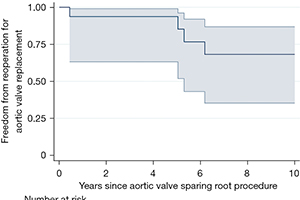Aortic valve-sparing procedure in the pediatric population
Abstract
Background: Aortic valve-sparing procedures have been established as a mainstream treatment option for adult patients with aortic root aneurysms. However, data regarding their use in the pediatric population is limited. This study reports on our experience with aortic valve-sparing procedures in children.
Methods: A retrospective review was conducted of all patients who underwent an aortic valve-sparing procedure at the Royal Children’s Hospital, Melbourne, Australia between April 2006 and April 2016. Clinical and echocardiographic data were analyzed.
Results: The study included 17 patients, with a median age of 15.7 years and a majority of patients being male (82.4%). The most common diagnosis was transposition of great arteries after arterial switch operation, followed by Loeys-Dietz syndrome and Marfan syndrome. Preoperative echocardiography showed more than moderate aortic regurgitation in 94.1% of the patients. The David procedure was performed in all 17 patients,
with no mortality during follow-up. Reoperation was required in 29.4% of patients, and 23.5% required aortic valve replacement. Freedom from reoperation for aortic valve replacement at 1, 5, and 10 years was 93.8%, 93.8% and 68.2% respectively.
Conclusions: Aortic valve-sparing surgery can be successfully performed in the pediatric population. However, it requires a highly skilled surgeon due to the often dysplastic or distorted nature of these valves and the need for additional procedures on the aortic valve leaflets.
Cover






